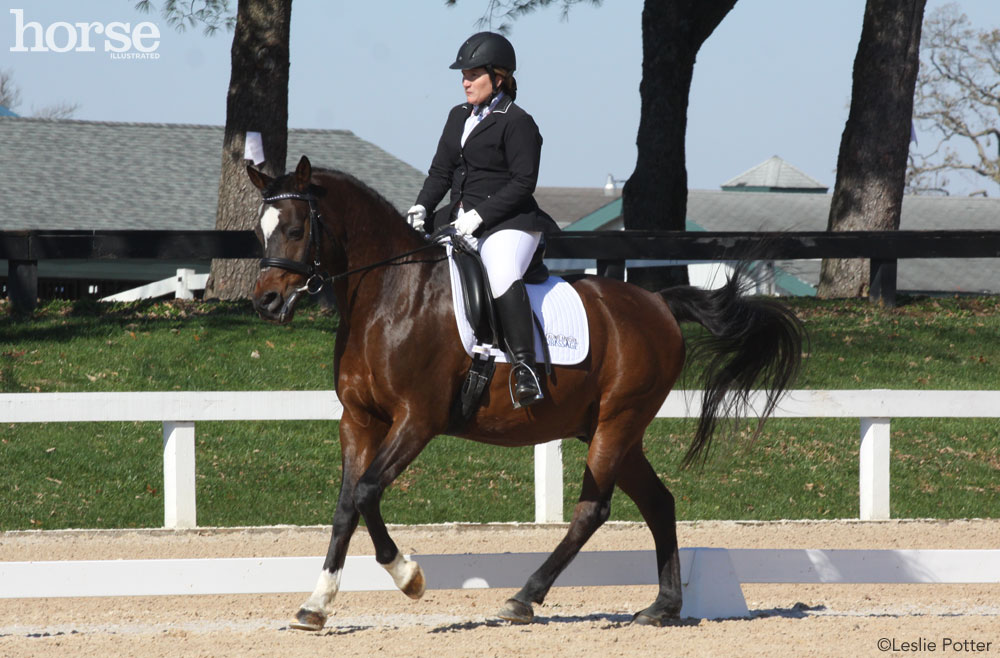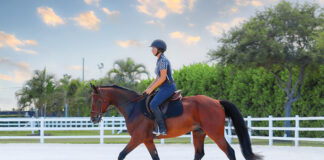
The Ideal Transition
Olsen says that a good upward transition should look easy and fluid. The horse should be supple and maintain his balance in a collected frame without losing his rhythm. The horse shouldn’t change his balance drastically. If you go from trot to the canter, the only thing that should change is the gait.
For a smooth downward transition, your horse needs to shift his weight and energy to his hindquarters so he can easily lift his front end. If he doesn’t drive his hindquarters underneath him, even in trot to walk, the transition will be bumpy and appear awkward.
Remain Seated
Riding the transition can be difficult if your horse is unsteady or unbalanced. However, Olsen says that riders should still maintain a proper seat. “The rider should stay in the correct position no matter what happens. Many times riders will collapse their position or lean forward. When they change their position, it affects the horse’s balance. If you don’t stay correct in your position, you’ll actually cause the horse to be more off-balance and more on the forehand.” For this reason, Olsen emphasizes the importance of developing an independent seat.
Aids for the Transition
In the downward transition, weight your seat down. But don’t force it, says Olsen. “If you brace your back and shove, the horse will brace his back against you. You have to lift your back as much as you push your weight down. In the canter, your inside seat bone is prominent. When you come [down] to the trot, drop your weight into both seat bones. As the horse comes into the transition, lift your chest to soften [your seat]. This will help the horse’s shoulders stay light.”

Make sure that your seat changes to minimize your horse’s movement as he changes gait. Your seat should swing slightly from side to side in the walk, up and down in the trot, and forward and back in the canter.
For the upward transition, apply the aid appropriate for the gait; for example, inside seat bone and outside leg if you’re going into the canter. Ride a half-halt before, during and after an upward transition — just a simple close and release of the hands. Olsen says to allow the transition to happen naturally. Don’t get restrictive with your hands, or you will lose the rhythm of the gait [and] restrict your horse’s hindquarters. “If you get desperate for the transition, you forget to ride,” she says. “Sometimes less is more, but being very still and quiet is sometimes the hardest thing. If the rider thinks about riding to the best of his or her ability, the horse will get better and better.”
Common Faults and Fixes
Not a Head Case
Many riders get too wrapped up with the horse’s head, so Olsen reminds them to stay light in their contact with the bit, and to try not to pull on the reins. “Keep a steady contact. The horse will make the transition with whatever strength he has for that day. If you force the head up or down, the transition will be forced. As you do more transitions, the horse will have increased strength behind.”
Failure to Communicate
If your horse constantly runs in or out of a transition, he’s probably misunderstanding the aids. He may think you simply want him to trot faster. “The horse can get confused and frustrated and not know what to do,” says Olsen. “To me, miscommunication is a rider’s error more than the horse’s. Half-halt, bring the horse back and try again. Never chase the horse into the gait. It’s important that he understand exactly what you want. When starting a young horse, it’s important to teach him the voice aids on the longe. Then use your voice in the saddle along with [your seat and leg] so he understands. Keep your seat the same; don’t change it just because he doesn’t understand.” She recommends going back to the longe to reinforce voice aids if the horse is still having a problem.
Unclear on Leg Aids
If your horse doesn’t go when you ask him to, there are exercises you can do to get him to understand your leg aids. “Take a few steps of turn on the forehand, and then ask for the trot or the canter,” says Olsen. “This exercise is also beneficial because as the inside hind leg crosses over, the inside hip has to lower and the inside shoulder has to come up. It’s a great way to [improve his] lightness and balance. You can also use a few steps in the leg yield, then ask for the transition upward to create a similar effect.”
A shoulder-fore (a precursor to the shoulder-in with the body at a slighter angle) will help the horse with his downward transitions. When you ride the shoulder-fore correctly, the horse has to lower his inside hip and raise his inside shoulder. In the canter, using the shoulder-fore for the downward transition also helps him stay straight.
A huge part of the horse’s training shows up in the transitions. Proper transitions demonstrate that he is correct and balanced. “They give you a clue of where your horse is in his training,” says Olsen. “If you can make a smooth change from one gait to another, celebrate your horse’s good training and your excellent seat and position!”
More on canter transitions >>
This article originally appeared in the April 2008 issue of Horse Illustrated. Click here to subscribe.







I struggled with this concept for a while
I was also having a hard time having smooth gait transitions.
[…] Bron: Horseillustrated […]